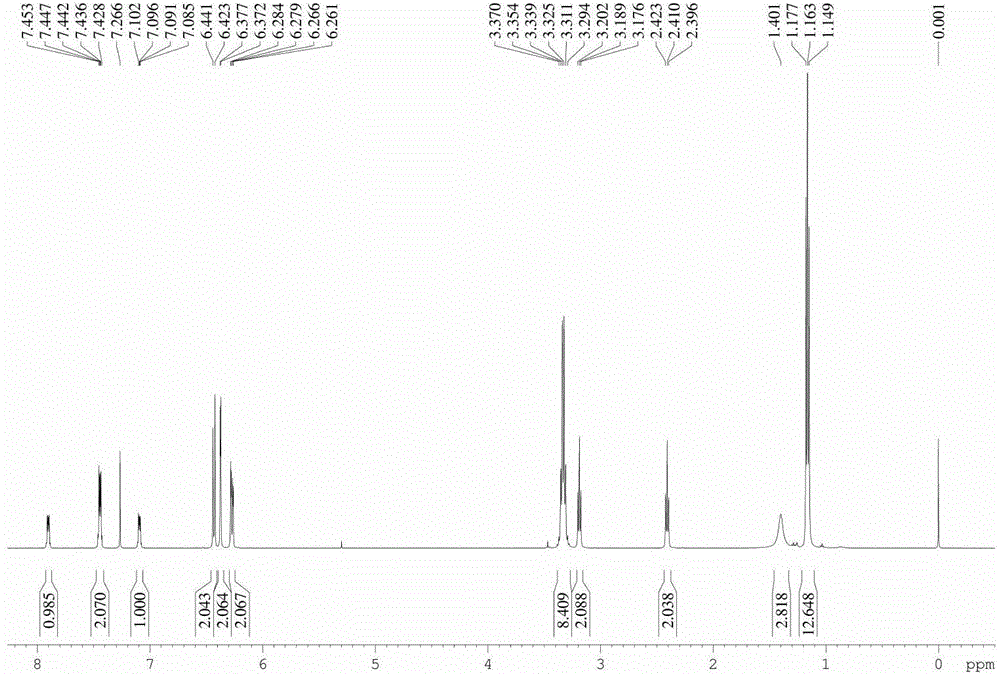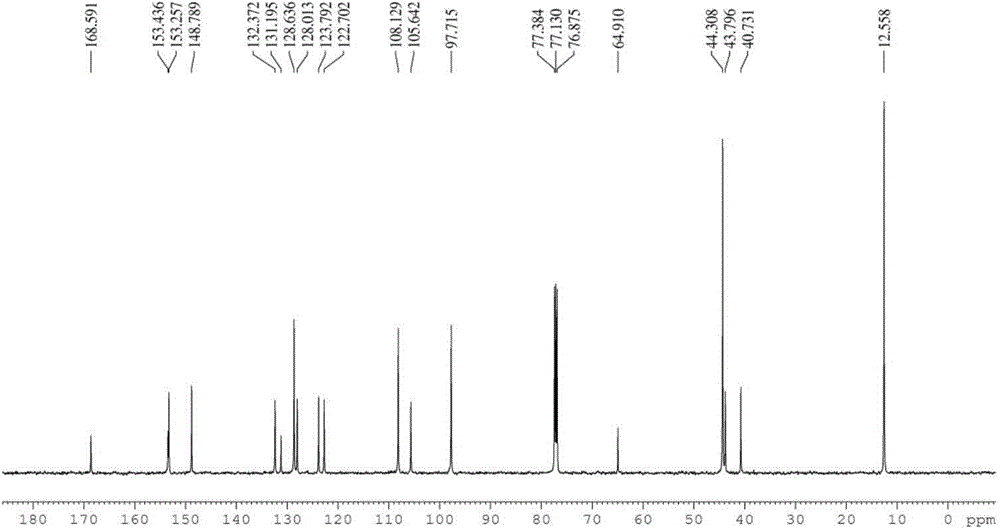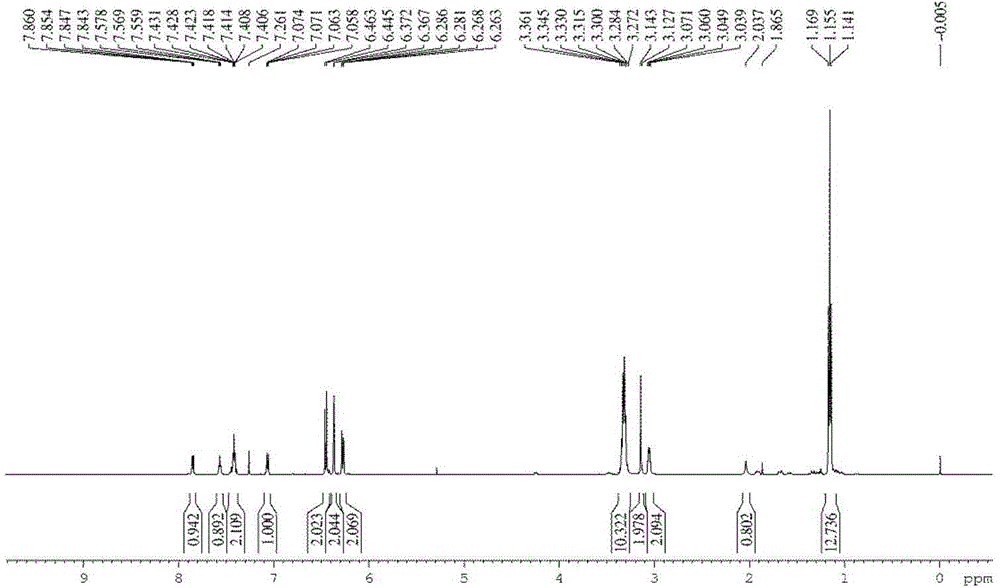Cr<3+> sensor based on rhodamine B as well as preparation and application of Cr<3+> sensor
A fluorescence sensor and reaction technology, applied in the field of biochemistry, can solve the problems of not particularly good selectivity, low reaction yield, and many synthesis steps, and achieve the effects of simple synthesis steps, high sensitivity, and simple synthesis methods.
- Summary
- Abstract
- Description
- Claims
- Application Information
AI Technical Summary
Problems solved by technology
Method used
Image
Examples
Embodiment 1
[0038] Synthesis of fluorescent chemical sensors
[0039] 1. Synthesis of Compound 2
[0040] Rhodamine B (960mg, 2mmol) and ethylenediamine (1.3ml, 20mmol) were dissolved in absolute ethanol (40ml), the reaction temperature was controlled at 80°C, and the reaction time was 12h. After the reaction was completed, the solvent was removed under reduced pressure, and extracted , separated by silica gel column to obtain light yellow solid (880 mg, 92%). Compound 2 1 H NMR, 13 C NMR respectively as figure 1 , figure 2 shown.
[0041] 2. Synthesis of compound 3
[0042]Compound 2 (121mg, 0.25mmol) was dissolved in dichloromethane (5ml), and DCC (N,N'-dicyclohexylcarbodiimide, 62mg, 0.3mmol), HOBT (1-hydroxybenzotriazole , 40mg, 0.3mmol), TEA (N,N-diethylethylamine, 52uL, 0.375mmol), then added thiodiglycolic acid (19mg, 0.125mmol), after the reaction was completed, the solvent was removed under reduced pressure, extracted, After column separation, a light red solid (105 mg, ...
Embodiment 2
[0044] UV selective performance test
[0045] Cr 3+ Fluorescent sensor 3 has good solubility in methanol. It has been verified that compound 3 can be dissolved in MeOH:HEPES (10mM, pH=7.2) = 3:1 mixture, and 500ml of this solution was prepared as a stock solution (pH=7.2 ).
[0046] Precise configuration of Cr 3+ Fluorescence sensor 3 is 1×10 -3 mol / L MeOH-H 2 O mixed solution (3 / 1, V / V), metal ion Cr 3+ , Ca 2+ , Ag + , Mg 2+ , Na + , K + , Ba 2+ ,Co 2+ , Zn 2+ , Li + , Cd 2+ , Fe 2+ , Cu 2+ , Cu + , Mn 2+ , Pb 2+ , Hg 2+ , Cs 2+ , Al 3+ , Ni 2+ , Fe 3+ Isoconcentration is 5×10 -3 mol / L aqueous solution, and MeOH:HEPES (10mM, pH=2.1, 3 / 1, V / V) solution.
[0047] UV selectivity experiments such as Figure 5 As shown, take 3ml stock solution and put it in the liquid pool, add 60uL Cr 3+ Fluorescent sensor 3 solution, measure its initial ultraviolet absorption value, and then add 60uL of various metal ion solutions prepared respectively, and measure i...
Embodiment 3
[0049] Fluorescent selective performance test
[0050] Cr 3+ Fluorescent sensor 3 has good solubility in methanol. It has been verified that compound 3 can be dissolved in MeOH:HEPES (10mM, pH=7.2) = 3:1 mixture, and 500ml of this solution was prepared as a stock solution (pH=7.2 ).
[0051] Precise configuration of Cr 3+ Fluorescence sensor 3 is 1×10 -3 mol / L MeOH-H 2 O mixed solution (3 / 1, V / V), metal ion Cr 3+ , Ca 2+ , Ag + , Mg 2+ , Na + , K + , Ba 2+ ,Co 2+ , Zn 2+ , Li + , Cd 2+ , Fe 2+ , Cu 2+ , Cu + , Mn 2+ , Pb 2+ , Hg 2+ , Cs 2+ , Al 3+ , Ni 2+ , Fe 3+ Isoconcentration is 5×10 -3 mol / L aqueous solution, and MeOH:HEPES (10mM, pH=2.1, 3 / 1, V / V) solution.
[0052] Fluorescent selectivity experiments such as Image 6 As shown, take 3ml stock solution and put it in the liquid pool, add 60uL Cr 3+ Fluorescence sensor 3 solution, measure its initial fluorescence intensity value, and then add 60 uL of various metal ion solutions prepared respecti...
PUM
 Login to View More
Login to View More Abstract
Description
Claims
Application Information
 Login to View More
Login to View More - R&D
- Intellectual Property
- Life Sciences
- Materials
- Tech Scout
- Unparalleled Data Quality
- Higher Quality Content
- 60% Fewer Hallucinations
Browse by: Latest US Patents, China's latest patents, Technical Efficacy Thesaurus, Application Domain, Technology Topic, Popular Technical Reports.
© 2025 PatSnap. All rights reserved.Legal|Privacy policy|Modern Slavery Act Transparency Statement|Sitemap|About US| Contact US: help@patsnap.com



